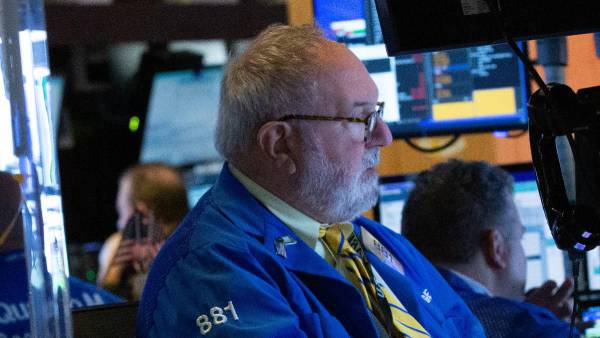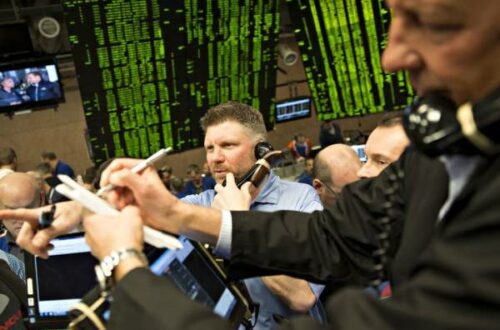
Dow futures falls almost 500 points as stress among Russia and Ukraine
Stock prospects fell forcefully early Tuesday morning, as dealers keep on observing blending strains among Russia and Ukraine.
U.S. stock-record fates were pointedly lower early Tuesday, however off the most obviously awful levels for the time being, when Russian President Vladimir Putin requested the sending of troops to dissident regions inside Ukraine, subsequent to perceiving their freedom, a move that some dread puts Ukraine and Russia one bit nearer to military clash.
Prospects attached to the Dow Jones Industrial Average were somewhere near 493 focuses, or 1.39%. S&P 500 fates slid 1.74%, and Nasdaq 100 fates were off by 2.6%. The U.S. financial exchange was shut Monday because of the President’s Day occasion.
Markets in the U.S. were shut in recognition of Presidents Day and exchange on Tuesday will give the principal opportunity to financial backers to respond to advancements in Eastern Europe.
Oil costs rose, with West Texas Intermediate fates bouncing 3.95% to $94.67 per barrel.
Russian President Vladimir Putin said Monday that he would perceive the autonomy of two breakaway districts in Ukraine, conceivably undermining harmony converses with President Joe Biden. That declaration was trailed by news that Biden was set to arrange sanctions on nonconformist areas of Ukraine, with the European Union vowing to go to extra lengths.
On Friday, the Dow DJIA, – 0.68% dropped 232.85 focuses, or 0.7%, to close at 34,079.18; the S&P 500 SPX, – 0.72% fell 31.39 focuses, or 0.7%, to end at 4,348.87; and the Nasdaq Composite COMP, – 1.23% declined 168.65 focuses, or 1.2%, to complete at 13,548.07. An alleged demise cross solidified in the Nasdaq, a negative diagram design.
Putin later arranged powers into the two breakaway districts.
The news came after the White House said Sunday that Biden has acknowledged “on a fundamental level” to meet with Putin in one more work to deescalate the Russia-Ukraine circumstance through tact. White House press secretary Jen Psaki said the culmination between the two chiefs would happen after a gathering between Secretary of State Antony Blinken and his Russian partner Sergey Lavrov.
For the week, the Dow booked a 1.9% droop, the S&P 500 fell 1.6% and the Nasdaq Composite finished down 1.8%, denoting the second back to back seven day stretch of decreases.
The Russia-Ukraine struggle has placed tension on market opinion as of late, with the significant midpoints presenting back-on back week after week misfortunes. The Dow fell 1.9% last week, and the S&P 500 and Nasdaq Composite slid 1.6% and 1.8%, individually.
What’s driving the market?
The White House said President Joe Biden will give a leader request that “will disallow new speculation, exchange, and financing by U.S. people” in those areas.
Markets were set for large misfortunes on Tuesday as Putin requested powers Monday to “keep up with harmony” in dissenter districts of eastern Ukraine. The declaration raised feelings of trepidation, which have kept financial backers sketchy, that an intrusion was going to emerge.
In the mean time, authorities from the European Union alluded to Putin’s most recent moves, including the acknowledgment of the autonomy of the Russian dissident Donetsk and Luhansk areas’ freedom, as “a barefaced infringement of worldwide regulation.”
Brokers are additionally watching out for the Federal Reserve, as the U.S. national bank is relied upon to raise rates on different occasions beginning one month from now. As per the CME Group’s FedWatch device, merchants are wagering that there is a 100 percent chance of a Fed rate climb after the March 15-16 gathering.
“The greater part of the auction in worldwide values this year can be ascribed to the hawkish shift by the world’s significant national banks,” Neil Shearing, Group Chief Economist, at Capitol Economics, wrote in a note to clients early Tuesday. “This recommends that there is as yet huge drawback for worldwide securities exchanges (and potential gain for places of refuge, including US Treasuries) assuming the contention raises.”
“Everyone’s attention is on the Fed,” Strategas venture tactician Ryan Grabinski wrote in a note delivered Friday evening. “Starting today, the market is anticipating that the Fed should raise loan costs at virtually every gathering this year. Notwithstanding that, we left Monetary Policy as Favorable for the present on the grounds that the Fed is proceeding to buy Treasuries (an accommodative arrangement activity).”
Markets have been disrupted to some extent somewhat because of worries of a Russian extension of Ukraine, which could prompt more noteworthy worldwide pressures. Unrefined petroleum fates and those for flammable gas NG00, 2.82% have been for the most part floated by intrusion fears, with West Texas Intermediate rough CL.1, +4.85% CL00, 4.61% exchanged on the New York Mercantile Exchange, the U.S. benchmark contract, exchanging at another long term high early Tuesday.
Assumptions for more tight money related approach have placed tension on stocks, especially those in rate-delicate areas like tech, and have sent Treasury yield forcefully higher to begin 2022. The benchmark 10-year Treasury yield finished last week around 1.93% after momentarily breaking above 2%. The 10-year started 2022 exchanging at around 1.51%.
In the interim, Wall Street is planning for the last part of the corporate income season, with Home Depot and eBay among the organizations set to report this week. It has been a strong income season so far: Of the in excess of 400 S&P 500 organizations that have posted final quarter profit, 77.7% have beaten expert assumptions, as per report.
Mia is a literature author. Mia was not interested in becoming a writer when she was a child, a fact which she himself admits that separates her from fellow writers she has met. As a young adult, Mia did not know what she wanted to be. she remembered, however, how in high school, she had been a class clown, and that made her decide to become a books writer. Later on, she moves toward the writing news articles. In recent she writes her news on Stock Invests.
Disclaimer: The views, suggestions, and opinions expressed here are the sole responsibility of the experts. No STOCK INVESTS journalist was involved in the writing and production of this article.





